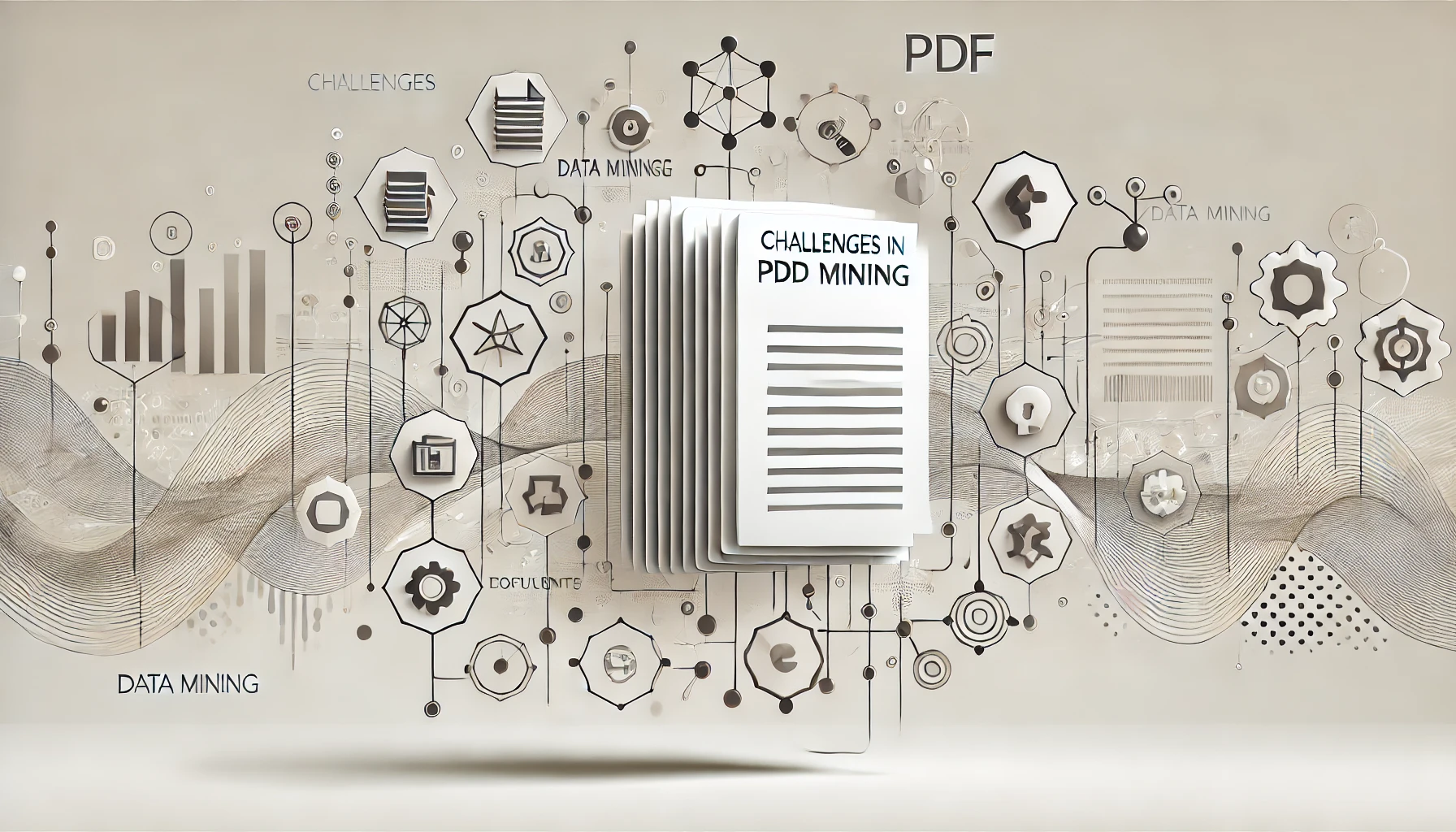Explore how PDF data mining revolutionizes academia, business intelligence, legal analysis, and healthcare. Uncover how this technology uncovers hidden patterns and trends in data, driving strategic decision-making and improving outcomes. The applications of PDF data mining extend beyond mere information retrieval, offering a glimpse into the future of innovation across various sectors. From market research insights to compliance monitoring advancements, the possibilities are endless.
Academic Research
Within the realm of academic research, PDF data mining plays a crucial role in extracting valuable insights from vast amounts of scholarly articles, reports, and publications. Citation analysis is a fundamental aspect of academic research, and PDF data mining enables the automated extraction and analysis of citations within documents. By identifying patterns in citation clusters, researchers can uncover relationships between different works, leading to a better understanding of the academic landscape.
Moreover, author profiling is another key area where PDF data mining proves invaluable. By analyzing the writing style, topics, and collaborations of authors across multiple documents, researchers can gain insights into the expertise and interests of individual authors. This information can be utilized to facilitate author collaboration, identify potential research partners, and enhance the quality of academic publications.
Business Intelligence
Business intelligence relies heavily on data analysis to drive strategic decision-making within organizations. By utilizing data visualization techniques, businesses can transform raw data into actionable insights that inform key business strategies. Market analysis plays a crucial role in identifying trends, customer preferences, and competitive landscapes. Through PDF data mining, organizations can extract valuable information from market reports, competitor analyses, and industry trends to gain a competitive edge.
Competitive intelligence involves gathering, analyzing, and utilizing information about competitors to make informed decisions. PDF data mining enables businesses to extract competitor data from various sources and conduct detailed comparisons to identify strengths, weaknesses, opportunities, and threats.
Integrating PDF data mining into business intelligence processes enhances decision-making by providing access to comprehensive and up-to-date information. By leveraging advanced analytics and visualization tools, organizations can uncover valuable insights, optimize operations, and drive growth. Embracing innovative data mining technologies ensures that businesses stay ahead of the competition and make informed, strategic decisions.
Legal Document Analysis
To extract valuable insights from legal documents, organizations can leverage PDF data mining techniques to analyze a vast array of legal texts efficiently. Through case law analysis, businesses can uncover patterns, precedents, and judicial reasoning that can inform their legal strategies and decision-making processes. By applying PDF data mining to case law documents, organizations can quickly identify relevant rulings, trends, and outcomes, enabling them to make more informed legal decisions.
Furthermore, contract review can be significantly enhanced through PDF data mining. By utilizing text extraction and analysis tools, businesses can efficiently review and compare contracts, identifying key clauses, terms, and potential risks. This streamlined approach to contract analysis can save time and resources while ensuring thorough scrutiny of important legal documents.
Medical Record Analysis
For efficient and insightful analysis of medical records, PDF data mining presents a cutting-edge solution. By utilizing this technology, healthcare professionals can delve into vast amounts of patient data to uncover valuable insights regarding patient outcomes and disease trends. PDF data mining enables the extraction of crucial information from medical records, allowing for a comprehensive analysis of treatment effectiveness, disease progression, and overall healthcare trends.
Through the analysis of medical records using PDF data mining techniques, patterns in patient outcomes can be identified. This analysis can help healthcare providers improve treatment protocols, enhance patient care, and ultimately lead to better health outcomes. Additionally, by studying disease trends within the data, medical researchers can gain a deeper understanding of prevalent health conditions, their impact on populations, and potential areas for intervention and prevention strategies.
Market Research
Utilizing advanced PDF data mining techniques for market research offers unparalleled insights into consumer behavior, industry trends, and competitive landscapes. By extracting valuable information from PDF documents, you can gain a deep understanding of consumer preferences, purchase patterns, and sentiment analysis. Analyzing consumer behavior through PDF data mining allows you to identify emerging trends, predict future market demands, and tailor your strategies to meet consumer needs effectively.
Furthermore, conducting competitive analysis using PDF data mining enables you to benchmark your performance against industry rivals, track market share fluctuations, and identify potential threats or opportunities. By examining competitors’ pricing strategies, product offerings, and customer reviews embedded in PDF files, you can make informed decisions to stay ahead in the market.
Content Aggregation
Content aggregation involves the collection and consolidation of information from multiple sources into a unified platform. In the realm of social media, content aggregation tools sift through various social platforms to gather posts, comments, and user-generated content, providing a comprehensive overview of trending topics and public sentiment. These tools enable businesses to monitor brand mentions, track competitors, and analyze consumer feedback efficiently.
On the other hand, in the context of news articles, content aggregation plays a crucial role in summarizing and categorizing vast amounts of news content from diverse publishers. By aggregating news articles on specific topics, users can stay informed about recent developments and access a wide range of perspectives in one centralized location.
Text Analytics
Text analytics, also known as text mining, involves the process of extracting valuable insights and patterns from unstructured textual data. Through sentiment analysis, text analytics can determine the sentiment expressed in a document, whether it is positive, negative, or neutral. This capability is particularly useful for businesses wanting to gauge customer satisfaction or public opinion on their products or services. Information retrieval is another key aspect of text analytics, enabling users to search and retrieve specific information from large volumes of text quickly and efficiently. By analyzing the content of documents, text analytics can help users locate relevant information without having to manually sift through each document. This process streamlines research tasks and makes data more accessible. In essence, text analytics offers a powerful tool for extracting valuable insights and improving decision-making processes based on the content of textual data.
Data Integration
When it comes to data integration in PDF data mining, you need to focus on merging data from various sources seamlessly. This process involves ensuring compatibility across different platforms to enhance the efficiency of data analysis. By integrating data sources effectively, you can obtain a comprehensive view of the information extracted from PDF documents.
Data Sources Integration
Data integration in the context of PDF data mining involves the seamless combination of diverse data sources to create a unified dataset for analysis. This process begins with data extraction, where information is gathered from various PDF documents. Data extraction tools are utilized to accurately retrieve text, tables, and images from these documents. Once the data is extracted, the next step is data manipulation. In this phase, the extracted data is cleaned, transformed, and structured to ensure consistency and compatibility across all sources. Techniques such as text parsing, data normalization, and entity recognition are employed to standardize the information for integration.
Data manipulation plays a crucial role in harmonizing the extracted data and resolving any inconsistencies or discrepancies that may arise from combining multiple sources. By performing effective data manipulation, analysts can ensure that the integrated dataset is ready for in-depth analysis and insights. This meticulous process of combining and refining data from various sources lays the foundation for meaningful interpretations and discoveries in PDF data mining.
Cross-Platform Compatibility
Ensuring cross-platform compatibility in data integration is paramount for efficient PDF data mining processes. When it comes to data extraction from PDF files, compatibility across different platforms is crucial to seamlessly integrate extracted data into various systems. This involves converting PDF files into formats that are universally accepted by different operating systems and software.
File conversion plays a significant role in achieving cross-platform compatibility for data integration. By converting PDF files into formats like CSV or XML, the extracted data can be easily imported into different databases or applications regardless of the platform being used. This streamlines the integration process and ensures that the extracted data can be effectively utilized across various platforms.
Compliance Monitoring
Utilizing PDF data mining for compliance monitoring purposes involves extracting pertinent information from documents to ensure adherence to regulatory standards and internal policies. Regulatory compliance is critical in various industries, and organizations often struggle to keep up with the ever-changing landscape of laws and regulations. By employing data extraction techniques on PDF documents, companies can streamline the process of monitoring and ensuring compliance.
Through PDF data mining, organizations can automatically scan documents for specific keywords, phrases, or patterns that indicate compliance or non-compliance with regulations. This automation not only saves time but also enhances accuracy by reducing the likelihood of human error in manual monitoring processes. Additionally, data extraction from PDF files allows for the aggregation and analysis of compliance-related data across multiple documents, enabling organizations to identify trends, discrepancies, and areas for improvement.
Sentiment Analysis
When conducting sentiment analysis through PDF data mining, organizations can delve into the emotional tone and opinions expressed within documents. This analysis involves extracting sentiment-related information from text data to gauge attitudes, emotions, and opinions. By applying sentiment analysis to PDFs, companies can gain valuable insights into customer feedback, employee sentiments, and public perception.
Social media plays a crucial role in sentiment analysis, as it provides a wealth of unstructured data for analysis. By mining PDF reports and documents from social media platforms, organizations can track trends, identify sentiment shifts, and monitor brand reputation in real-time. Understanding the sentiment expressed on social media can help businesses tailor their marketing strategies, improve customer service, and enhance brand perception.
Furthermore, sentiment analysis through PDF data mining allows organizations to proactively address potential issues, capitalize on positive feedback, and make informed decisions based on the sentiments conveyed in documents. This analytical approach is instrumental in maintaining a positive brand reputation and fostering stronger relationships with stakeholders.
Information Retrieval
To optimize information retrieval from PDF documents, you can employ text extraction techniques to extract relevant data efficiently. By utilizing metadata analysis tools, you can categorize and organize documents for quick access and retrieval. Implementing keyword search algorithms can further enhance the precision and speed of retrieving specific information from large datasets.
Text Extraction Techniques
Employing advanced text extraction techniques is crucial in the realm of PDF data mining, specifically when focusing on information retrieval. Data extraction plays a fundamental role in this process, allowing for the retrieval of valuable insights from PDF documents. Text recognition techniques are utilized to accurately identify and extract textual information from PDF files, enabling efficient analysis and organization of data.
Text extraction involves the systematic scanning of PDF documents to identify and extract relevant textual content. Through sophisticated text recognition algorithms, characters, words, and sentences are parsed and converted into machine-readable formats for further analysis. This process is essential for extracting key information such as names, dates, locations, and other important data points embedded within the text.
Metadata Analysis Tools
In the realm of PDF data mining, after successfully extracting textual content utilizing advanced techniques, the focus shifts towards analyzing metadata using specialized tools for information retrieval. Metadata analysis tools play a crucial role in understanding the structure and organization of files, providing valuable insights into the data they contain. These tools allow for the extraction of key information such as author details, creation dates, document titles, and keywords embedded within the PDF files.
File organization is a critical aspect of metadata analysis, as it helps in categorizing and sorting through large volumes of data efficiently. By examining metadata, data extraction becomes more streamlined, enabling researchers to locate specific information within the files quickly. Understanding the metadata associated with PDF documents is essential for effective data mining, as it provides a roadmap for retrieving relevant content based on specific criteria. By utilizing metadata analysis tools, researchers can enhance their information retrieval process and gain deeper insights from the data extracted.
Keyword Search Algorithms
Within the realm of PDF data mining, the utilization of Keyword Search Algorithms is paramount for efficient information retrieval. These algorithms play a crucial role in scanning through vast amounts of textual data to pinpoint relevant information based on user-defined keywords. Here are key aspects to consider when delving into Keyword Search Algorithms:
- Semantic Analysis: Keyword search algorithms incorporate semantic analysis techniques to understand the meaning behind words and phrases, allowing for more accurate search results.
- Document Clustering: By grouping similar documents together based on keyword relevance, document clustering enhances search efficiency and organization of information.
- Query Expansion: These algorithms often include query expansion functionalities, broadening search results by incorporating synonyms or related terms to capture a wider range of relevant documents.
- Relevance Ranking: Implementing relevance ranking mechanisms ensures that search results are sorted based on their significance, aiding users in quickly accessing the most pertinent information.
Data Visualization
Utilizing data visualization techniques in PDF data mining enhances the presentation of complex information in a visually accessible format. Interactive visualization allows users to explore data dynamically, gaining insights through manipulation and interaction. By incorporating interactive elements such as filters, sliders, and drill-down capabilities, PDF data mining enables users to delve deeper into the information presented, facilitating a more comprehensive understanding of the data patterns and relationships.
Data storytelling is another key aspect of data visualization in PDF data mining. It involves presenting data in a narrative format, guiding users through a structured story that highlights key findings and trends. This approach helps in making the data more engaging and understandable, enabling stakeholders to grasp the significance of the insights derived from the PDF documents.
Frequently Asked Questions
Can PDF Data Mining Extract Handwritten Text From Scanned Documents?
Yes, PDF data mining techniques can extract handwritten text from scanned documents. By leveraging advanced algorithms for handwritten recognition and scanned document analysis, the process efficiently converts handwritten content into digital text for further analysis and processing.
Is It Possible to Analyze PDFS in Languages Other Than English?
Yes, it’s possible to conduct multilingual analysis on PDFs. However, OCR challenges may arise when analyzing languages other than English due to varying character sets and writing styles. Implementing language-specific OCR models can help overcome these obstacles.
How Does PDF Data Mining Handle Encrypted or Password-Protected Files?
When handling encrypted files, PDF data mining employs decryption algorithms to unlock the content. Password-protected documents require specialized techniques to bypass security measures. These methods enable extraction and analysis of data from protected PDFs.
Can PDF Data Mining Identify and Extract Data From Tables and Graphs?
You can extract data visualization from tables and graphs through PDF data mining. It recognizes table structures and efficiently retrieves information, enhancing data analysis capabilities. This process streamlines data extraction and facilitates insights from visual representations.
What Are the Limitations of PDF Data Mining in Terms of File Size and Complexity?
When dealing with large file sizes and complex structures, challenges in PDF data mining emerge. Solutions involve employing advanced algorithms for efficient processing and implementing scalable systems to handle the varying degrees of complexity in the data.



